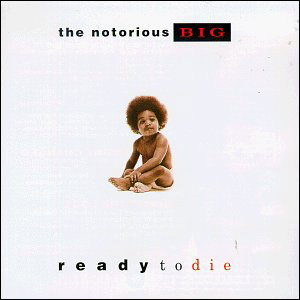
Ready to Die
Bad Boy, 1994
The opening of the ‘90s was an interesting time for hip-hop. Its mainstream profile was at an all-time high, and the West Coast not only began to get increased recognition, but also began to dominate commercially. While New York was still its spiritual home, in the early ‘90s the city seemed like a shadow of itself in the wake of Snoop Doggy Dogg, Dr. Dre and the G-Funk sound. Then 1994 came.
With 1994 came the release of iconic debut albums by the Wu-Tang Clan, Nas and Biggie Smalls, a.k.a. the Notorious B.I.G. While Wu-Tang and Nas helped re-establish the East Coast brand and enjoyed both street cred and some commercial success, B.I.G. and his Ready To Die were something entirely different. From the moment the album dropped, B.I.G. was anointed as “the King Of New York,” no small task considering Nas had previously been anointed the second coming of Rakim.
At first glance, the production line-up isn’t what you would call “all-star.” Yes, the legendary DJ Premier drops by, and the Trackmasters, who were on the rise, held down the boards for a couple of tracks, but Easy Mo Bee handled the bulk of the production duties. While not a rookie, he was mainly known as the producer of Miles Davis’ forgettable hip-hop record Doo Wop. It wouldn’t seem as if Ready To Die was primed for commercial success.
The first single from Ready To Die was the Mtume sampling “Juicy.” At first listen it’s deceptively simple. The track is pretty much a straight loop with little to no alteration of the original song. And while rap critics often deride rap as “talking over a beat,” the track took that approach to an almost comical exaggeration. But from the opening lines, “It was all a dream. I used to read Word Up magazine,” you’re instantly visualizing the scene as if it were a movie montage. You’re sucked into a picture painting a rags-to-riches story with hip-hop as the driving force. Compared to the feats of lyrical dexterity and aggressiveness on Biggie’s earlier remix appearances with Mary J. Blige, Super Cat and Craig Mack, “Juicy” seemed like it came from a different person.
But Ready To Die also has to rank as the masterwork of Puffy. If you only know Biggie from the radio singles then you’d be surprised and almost shocked at how rough, rugged and raw the record actually is. People are getting robbed, shots are being fired, and girls are getting their Number One Mom pendants taken away. However, while N.W.A., Dr. Dre and their contemporaries almost seem gleeful in their depiction of violence, Biggie’s narratives seem relentlessly downbeat and more real as a result. Puffy wisely knew that wouldn’t play on the radio so he chose and crafted the most radio-friendly tracks as the public face of B.I.G. While the album version of “One More Chance” has Biggie reassuring the ladies that he does have the “cleanest meanest penis,” the radio “remix” (which is actually a totally different song) manages the same effect but with a much more subtle approach. Oh, it’s still filthy, but in a charming way. It’s an approach taken throughout the album, the balance of street cred and commercial viability in perfect harmony.
Still there are some missteps. There’s no need to ever hear Biggie getting a blowjob or having loud angry sex blasting through your speakers, i.e. “#!@ Me (Interlude).” While the intro does set the scene, it goes on a bit long for what’s essentially a radio play. Still, 15 years down the line you can see why the Notorious B.I.G. remains a figure of public fascination.
Dorian S. Ham
PAST PERFECTS
Volcano Suns, The Bright Orange Years and All Night Lotus Party
Miles Davis, Kind of Blue
Swervedriver, Raise and Mezcal Head
Flipper, Generic, Gone Fishin', Public Flipper Limited, and Sex Bomb Baby!
Pavement, Brighten the Corners: Nicene Creed Edition
The Grifters, Ain't My Lookout
Blue Ash, No More, No Less
The Jesus and Mary Chain, The Power of Negative Thinking
New Order, The Collector's Editions
Kevin Ayers, What More Can I Say?
The Clash, Live at Shea Stadium
U2, Under a Blood Red Sky
Creedence Clearwater Revival, The 40th Anniversary Editions
Suicidal Tendencies, Suicidal Tendencies
